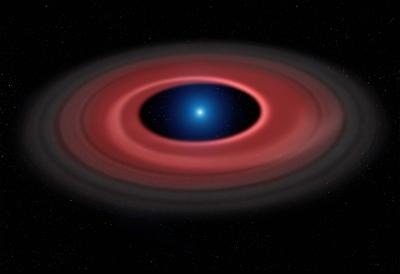May 15 2019
A new study led by the University of Warwick has discovered that small, hardy planets loaded with dense elements have a higher chance of avoiding being destroyed and gobbled up when their host star dies.
 An asteroid torn apart by the strong gravity of a white dwarf has formed a ring of dust particles and debris orbiting the Earth-sized burnt-out stellar core. (Image credit: University of Warwick/Mark Garlick)
An asteroid torn apart by the strong gravity of a white dwarf has formed a ring of dust particles and debris orbiting the Earth-sized burnt-out stellar core. (Image credit: University of Warwick/Mark Garlick)
Astrophysicists belonging to the Astronomy and Astrophysics Group have modeled the chances of destruction of different planets due to tidal forces when their host stars turn into white dwarfs and have identified the most important factors that govern whether they avoid being destroyed.
They have created a “survival guide” for exoplanets, which could assist astronomers in locating potential exoplanets surrounding white dwarf stars, since a new generation of much more robust telescopes is being built to look for them. The study has been reported in the Monthly Notices of the Royal Astronomical Society.
A majority of the stars, such as the Sun, will eventually run out of fuel, shrink in size, and turn into white dwarfs. Certain orbiting bodies that are not ruined in the tumult caused when the outer layers of the star are blasted away will subsequently undergo shifts in tidal forces when the star breaks down and turns out to be super-dense. The gravitational forces acting on any orbiting planets would be fierce and would possibly drag them into new orbits, even driving some further away from their solar systems.
The researchers modeled the impacts of the change in a white dwarf’s gravity on orbiting rocky bodies and have identified factors that are most likely to cause a planet to move inside the “destruction radius” of the star; the distance from the star at which an object held together only by its own gravity will break down because of tidal forces. A disk of debris from destroyed planets will be formed within the destruction radius.
Despite the fact that the survival of a planet is dependent on various factors, the models show that the size of the planet is directly proportional to the chances that it will be destroyed by tidal interactions.
However, destruction is not sure based on just the mass: exo-Earths with low viscosity are easily gobbled up even if they are located at separations within five times the distance between the center of the white dwarf and its destruction radius. Enceladus—Saturn’s moon that is often portrayed as a “dirty snowball”—is a good example of a homogeneous planet with a very low viscosity.
Exo-Earths that have high viscosity are easily gobbled up if they are located at distances within twice the separation between the center of the white dwarf and its destruction radius. These planets would be fully made of a dense core of heavier elements, with a composition similar to the “heavy metal” planet recently found out by another team of astronomers from the University of Warwick. That planet has avoided being swallowed in since it is as small as an asteroid.
The paper is one of the first-ever dedicated studies investigating tidal effects between white dwarfs and planets. This type of modelling will have increasing relevance in upcoming years, when additional rocky bodies are likely to be discovered close to white dwarfs. Our study, while sophisticated in several respects, only treats homogenous rocky planets that are consistent in their structure throughout. A multi-layer planet, like Earth, would be significantly more complicated to calculate but we are investigating the feasibility of doing so too.
Dr Dimitri Veras, Department of Physics, University of Warwick
Similar to the mass of the planet, the distance from the star has a strong link with engulfment or survival. There will always be a safe distance from the star, which is dependent on various parameters. More often, a rocky homogenous planet that is located at a specific location from the white dwarf that is more than about one-third of the distance between the Sun and Mercury is more likely to avoid being engulfed by tidal forces.
Our study prompts astronomers to look for rocky planets close to—but just outside of—the destruction radius of the white dwarf. So far observations have focussed on this inner region, but our study demonstrates that rocky planets can survive tidal interactions with the white dwarf in a way which pushes the planets slightly outward. Astronomers should also look for geometric signatures in known debris discs. These signatures could be the result of gravitational perturbations from a planet which resides just outside of the destruction radius. In these cases, the discs would have been formed earlier by the crushing of asteroids which periodically approach and enter the destruction radius of the white dwarf.
Dr Dimitri Veras, Department of Physics, University of Warwick
This study received support from the UK’s Science and Technology Facilities Council.